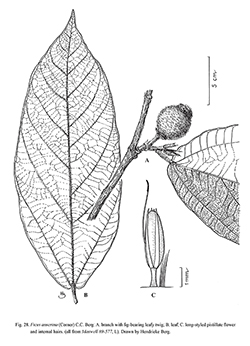e-Flora of Thailand
Volume 10 > Part 4 > Year 2011 > Page 579 > Moraceae > Ficus
SOE1. Ficus anserina (Corner) C.C.Bergwfo-0000509245
Thai Forest Bull. (Bot.) 35:5, t. 2. 2007.— Ficus pubigera var. anserina Corner, Gard. Bull. Singapore 18: 5. 1960. Fig. 28.
Accepted Name : This is currently accepted.
Description : Root-climber (or treelet to 5 m tall). Branchlets drying brown. Leafy twigs 3–5 mm thick, densely brown subvillous. Leaves in lax spirals to subdistichous; lamina oblong to subovate, 24–40 by 10–20 cm, (almost) symmetrical, subcoriaceous to coriaceous, apex acuminate, base (almost) equilateral, cordate to rounded, margin entire; upper surface brownish puberulous to strigillose mainly on the main veins, lower surface densely brown appressed-pubescent to -puberulous, on all veins or mainly on the main ones; cystoliths only below; lateral veins 6–8 pairs, the basal lateral veins to ca (¼–)⅓–½ the length of the lamina, branched, tertiary venation subscalariform, the smaller veins prominent beneath; waxy glands in the axils of the basal lateral veins (or also in the axils of some other lateral veins); petiole 0.5–2 cm long, 3–4 mm thick, brownish appressed-puberulous to -pubescent, the epidermis persistent; stipules (0.5–)1–1.5 cm long, brown to yellowish subsericeous, subpersistent or caducous. Figs (ramiflorous to cauliflorous?), below the leaves (on previous season’s growth or older wood and then on short, to ca 2 cm long short-shoots, solitary; peduncle 1.5–4 cm long; basal bracts 3–5 mm long, often ± scattered on the peduncle as far as the base of the receptacle, persistent; receptacle (sub) globose, ovoid or ellipsoid, when dry 2.5–5 cm, non-stipitate or to 1.5 cm long stipitate, densely brown subvillous, at maturity green or yellow to red (?), apex ± umbonate, ostiole ca 3–4 mm diam.; internal hairs abundant, long, stiff, and brownish. Tepals red, glabrous.
Thailand : NORTHERN: Chiang Mai, Chiang Rai, Nan, Lampang.
Distribution : China (Yunnan), Laos (type).
Ecology : Dry evergreen and montane forests, to 1,300 m alt.
Notes: This species differs from Ficus pubigera in the smaller number of lateral veins, of which the basal pair is distinctly branched and to 1/3–1/2 the length of the lamina, the persistent epidermis of the petiole, and the distinctly pedunculate figs.

